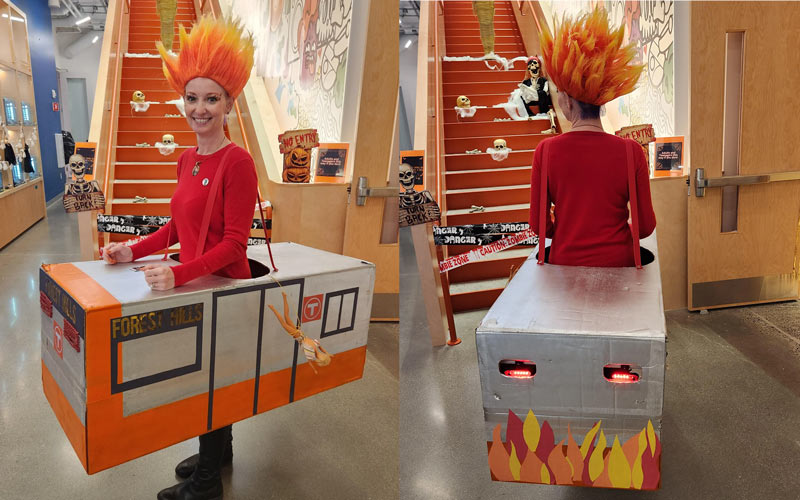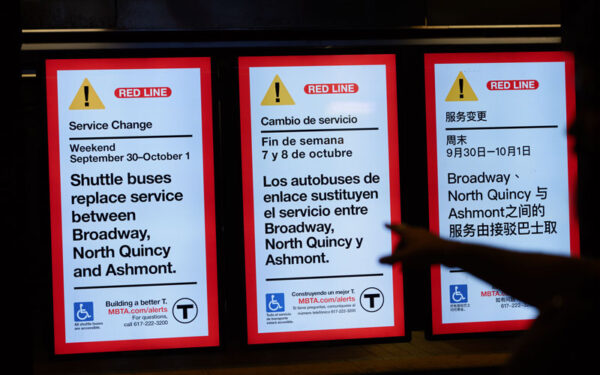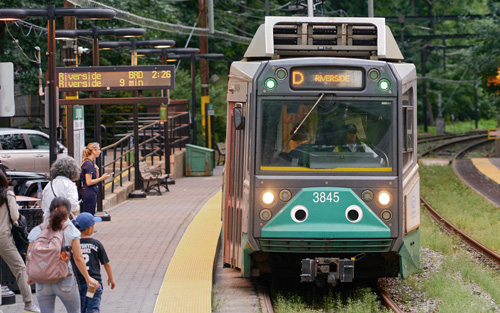
On Halloween, MBTA-inspired costumes help unbury some of the terrifying realities of our public transit system. Photo: Courtesy of @DawnOfTheThread.
Last Halloween, I saw something that perfectly captured the eerie reality of the MBTA. Dozens of people took to the streets of Boston, dressed as MBTA train cars. Some wore bright orange outfits with flame-styled hair – a nod to the infamous Orange Line fire that stranded passengers on a bridge. Others moved slowly, draped in green or red to mimic the sluggish Green and Red Lines. These weren’t just clever costumes; they reflected our real fears about relying on the T.
These costumes, though playful, starkly reminded me of the deeper issues haunting New England’s largest and busiest transit system. As a daily rider, I’ve seen firsthand how terrifying the MBTA can be. While it’s easy to joke about the T’s problems, some genuinely frightening realities need our attention.
Here are three terrifying truths about the MBTA that go beyond any Halloween costume:
1. The MBTA Is Dreadfully Underfunded
Picture the MBTA as a mummy, barely holding itself together with tattered bandages. That’s how it often feels, doesn’t it? The system serves over a million riders daily, yet it’s severely starved for funds. A bit more of that mummy unravels each year, revealing the decaying infrastructure beneath. The reality? The MBTA needs $24.5 billion to bring the system to a state of good repair. But instead of a grand revival, we’re stuck with a slow, collapsing system.
The root of the problem is clear: The MBTA needs more steady, reliable funding. Operating funds – the system’s lifeblood that should go to regular upkeep – are often diverted to patch up other areas. This quick fix leaves us all in the lurch.
We need real on-the-ground action to make our commutes easier, even as bigger fixes are in the works. The MBTA and our state government must emphasize to the legislature that this budget crisis is about much more than money, it’s about keeping people safe and connecting them to opportunities.
This isn’t a short-term problem; it’s a haunting issue that will persist until we secure the necessary funding to remake the system. The current approach? It’s like playing a never-ending game of transit whack-a-mole – it’s not working.
2. The MBTA Is a Crumbling Relic of the Past
Boston’s public subway system, dating back to 1897, is the oldest in the United States. This fact once made us proud. But now, its aging subway tunnels feel more like crumbling relics.
Our elected officials seem stuck in the past, too – failing to act urgently to save the system. Each legislative session that passes without action widens the cracks in the infrastructure, making the system even more vulnerable.
The MBTA’s age isn’t an excuse for its current state — it’s the result of years of neglect and underinvestment. By September 2024, the MBTA had already reported 27 derailments of maintenance vehicles in the year, a troubling sign of its frail status.
To revive this relic, we need more than bandages. We need our state government and legislature to seriously invest in both capital improvements and day-to-day operations. Without it, the MBTA will become nothing more than a ghost of its former self.
3. The Real Terror: Being Disconnected
Sure, riding the T can seem terrifying – trains catching fire, sudden breakdowns, never knowing if you’ll arrive on time for your class, work, or appointment. But even scarier is the idea of not having the T at all. Imagine being cut off from your job, school, friends, and family. Imagine having no way to get to the doctor or the grocery store.

For many, this isn’t a hypothetical – it’s a daily reality. A recent study found that over 30% of Boston households don’t have access to a car, making them dependent on public transit. Without reliable service, these families are left stranded and disconnected from critical opportunities.
On top of being a lifeline for many families, workers, and students, the T works as an engine that keeps our economy – including hospitals, academia, and industry – functioning. When the T loses its ability to service these businesses, it has catastrophic consequences that reverberate across the state.
That’s why we keep riding the Orange Line, the Red Line, and the commuter rail, even when they’re less than perfect. Being disconnected from our lives is far more frightening than any daily inconvenience.
But it’s not only those who ride the T who would feel the pain if it weren’t here. After all, the T fuels our entire state’s economy by bringing about $11.4 billion in economic benefits annually.
A Googly-Eyed Cry for Help
This year, some Boston subway trains started sporting googly eyes, adding a touch of whimsy to our daily commutes. But for many riders, those wide eyes reflect something else entirely: our wide-eyed disbelief that the MBTA still can’t get its act together.

But for many commuters, instead of lightening the mood, the googly eyes serve as a reminder of the serious issues that can’t be papered over with whimsical decoration.
The MBTA needs real, substantial change – not a bit of decoration – to make it faster, safer, and slightly less scary.
You Can Help
Your voice can make a difference. Talk to your state representatives and senators. Let them know the MBTA needs funds protected from being siphoned off. These funds are crucial for hiring and keeping staff, increasing wages, and putting in place a solid maintenance program – and training for operators, too. Without stable funding, the MBTA will continue zombie-ing from one crisis to the next.
At CLF, we’re advocating to improve the MBTA. We’re asking elected officials to increase funding to fix the trains to a state of good repair – and, in turn, make them better, faster, cleaner, and more resilient to extreme weather. That’s what we deserve.
Join us! Together, we can ensure that one day, the scariest thing about the MBTA will be the people riding the bus and train in their Halloween costumes.







